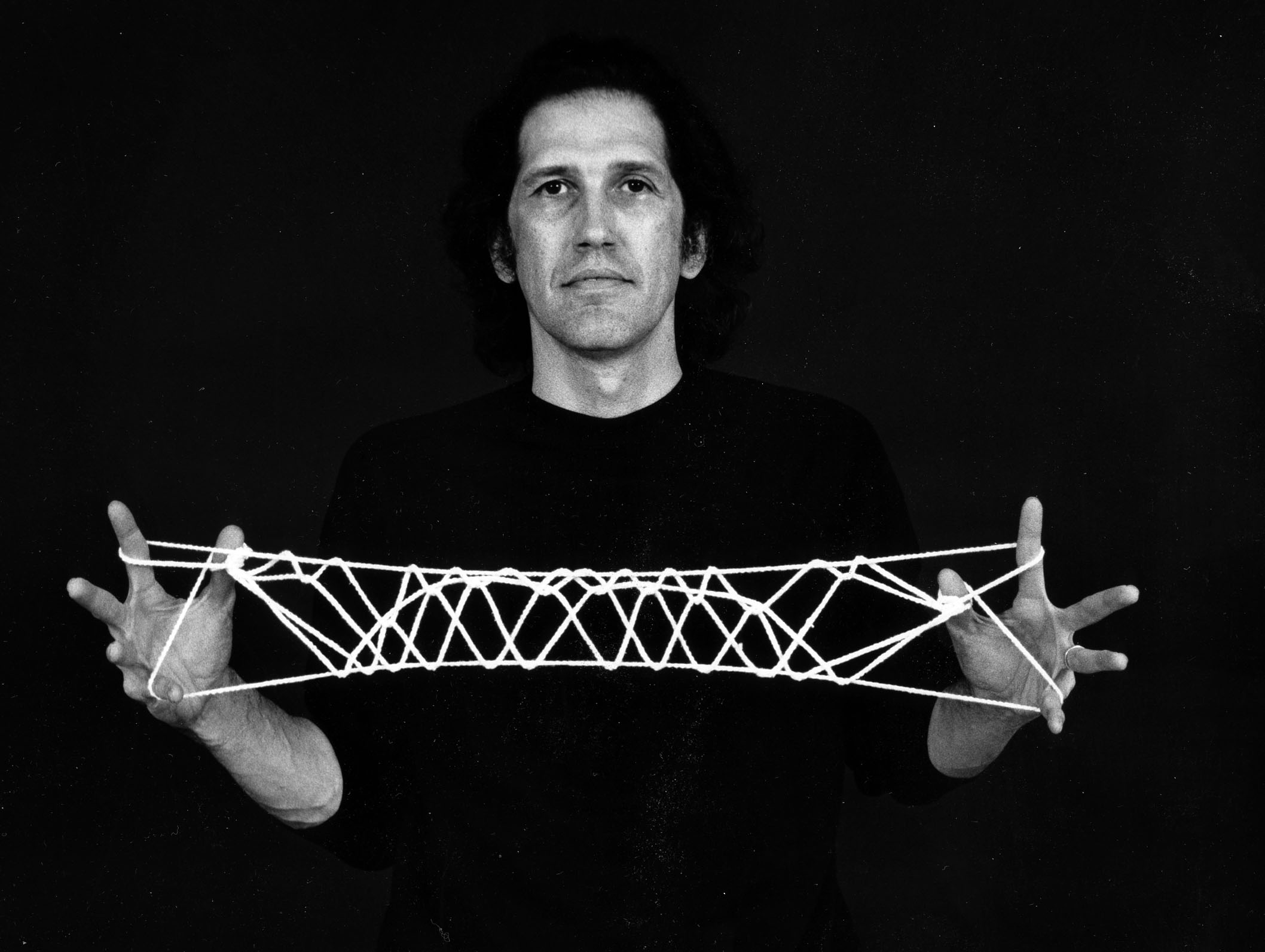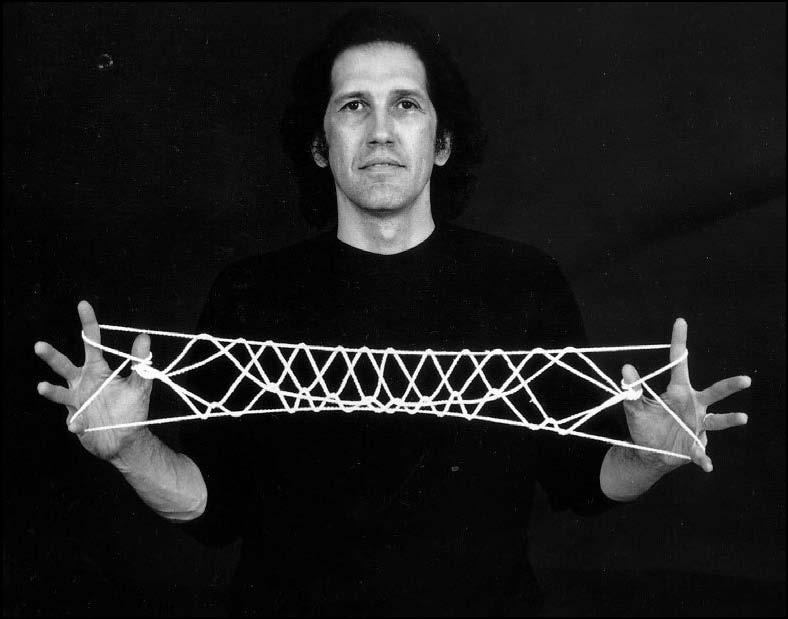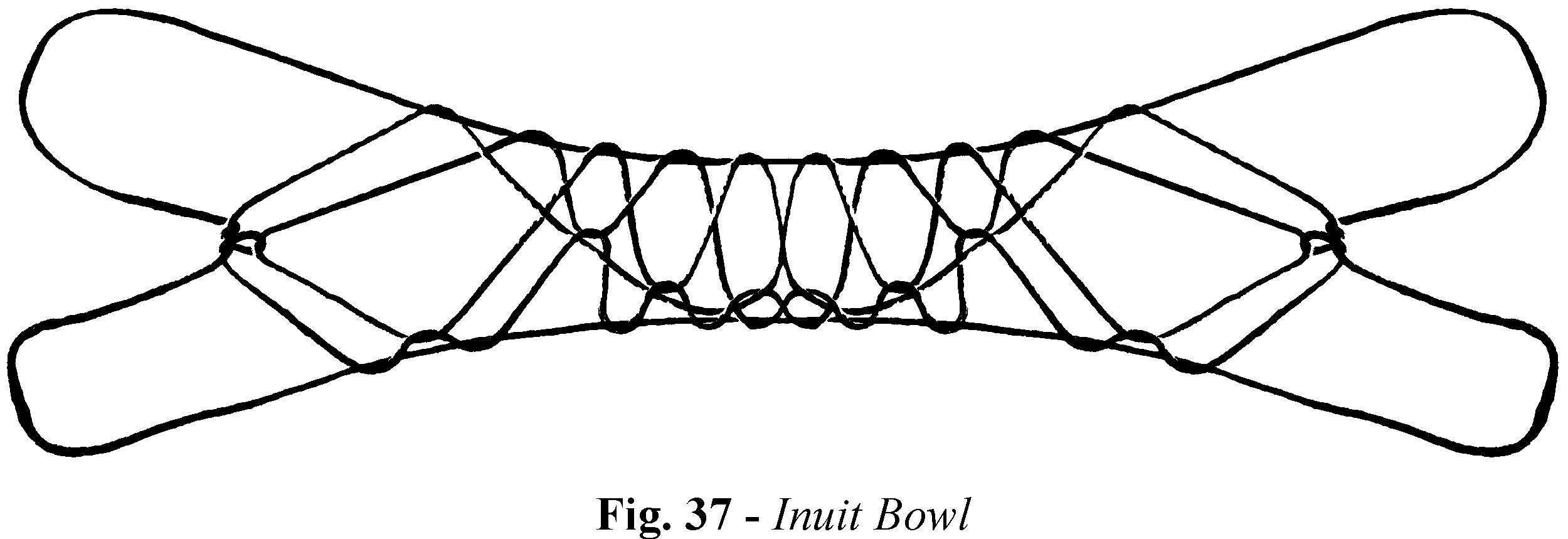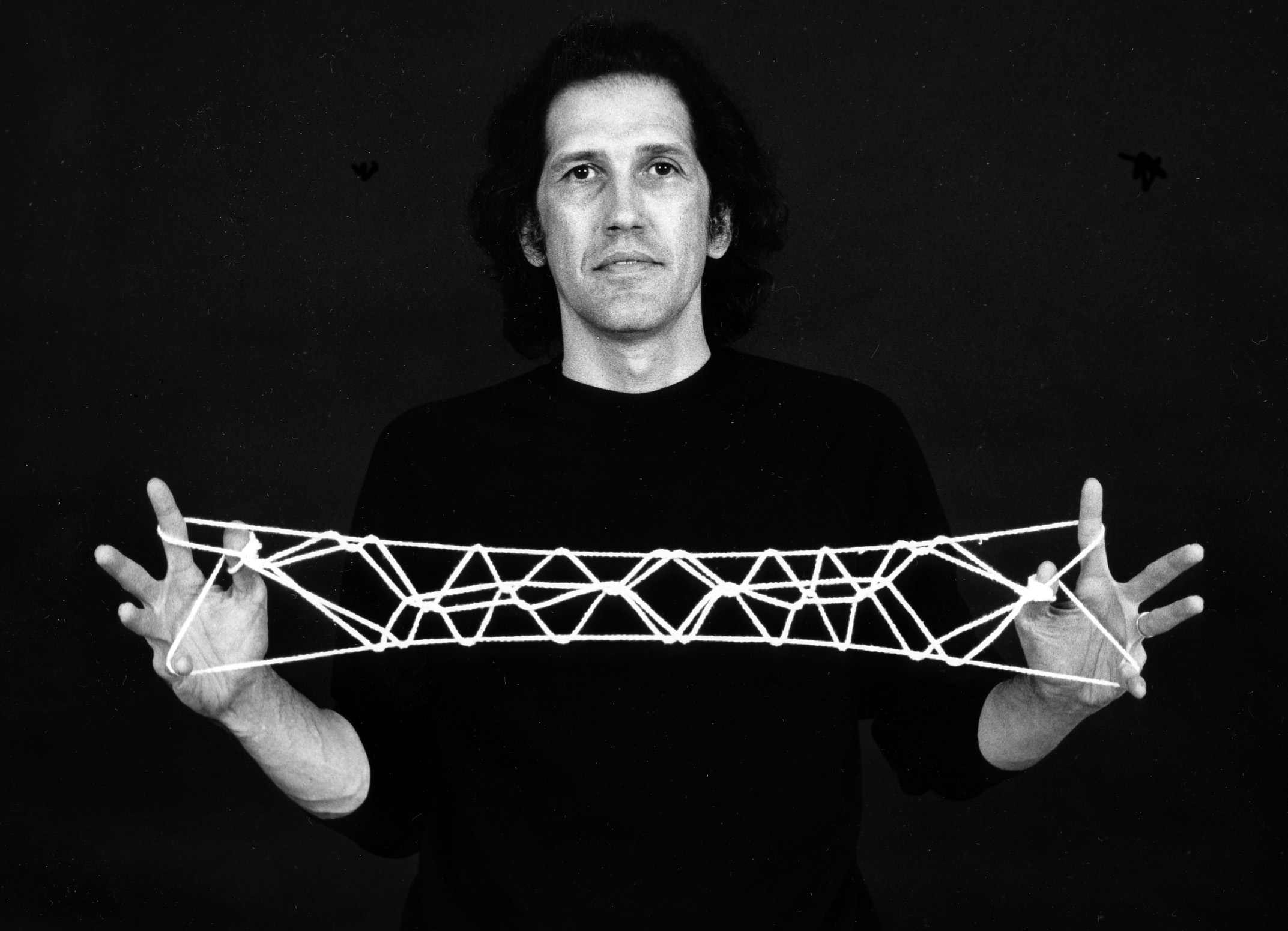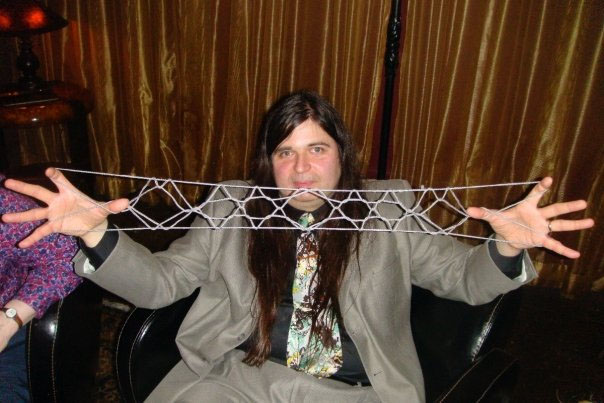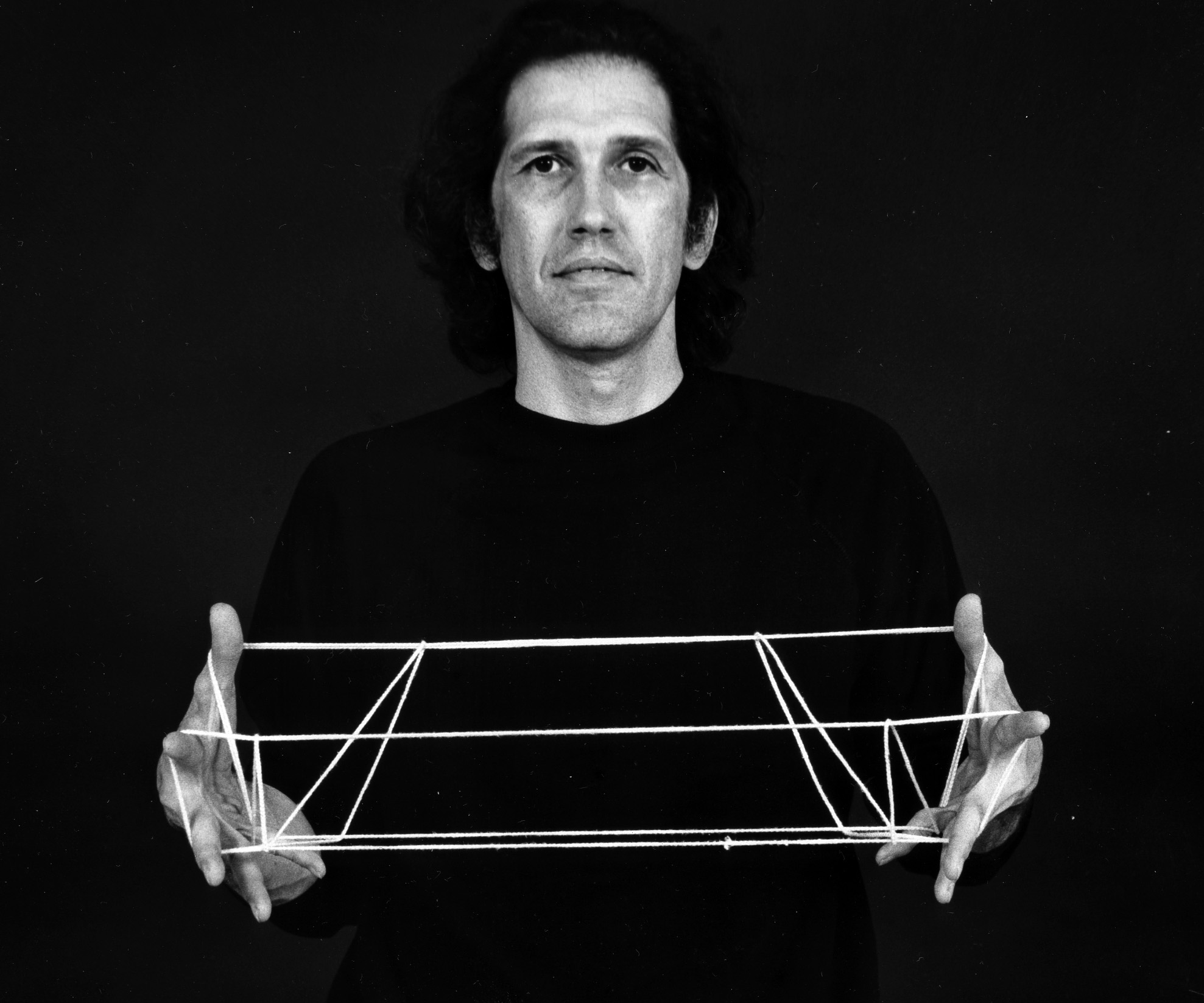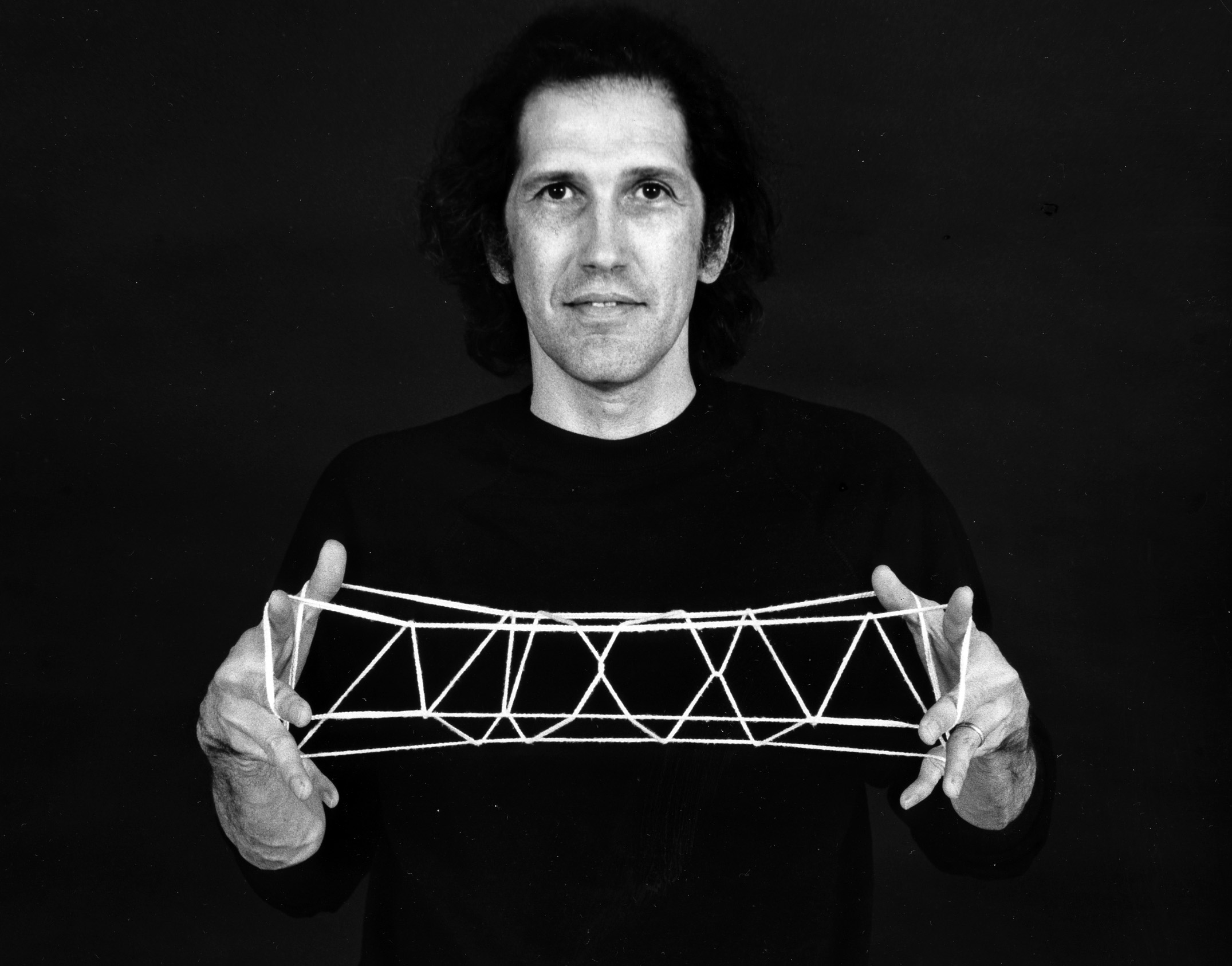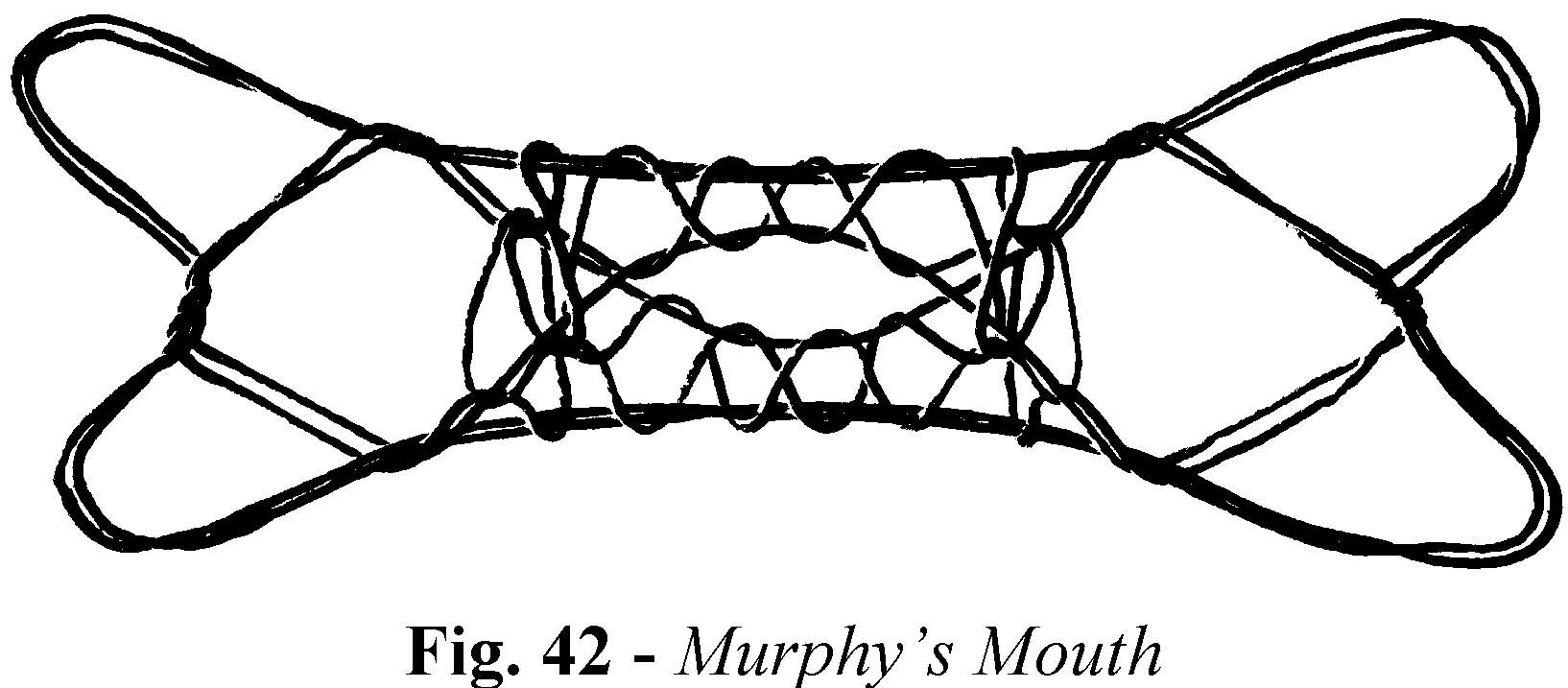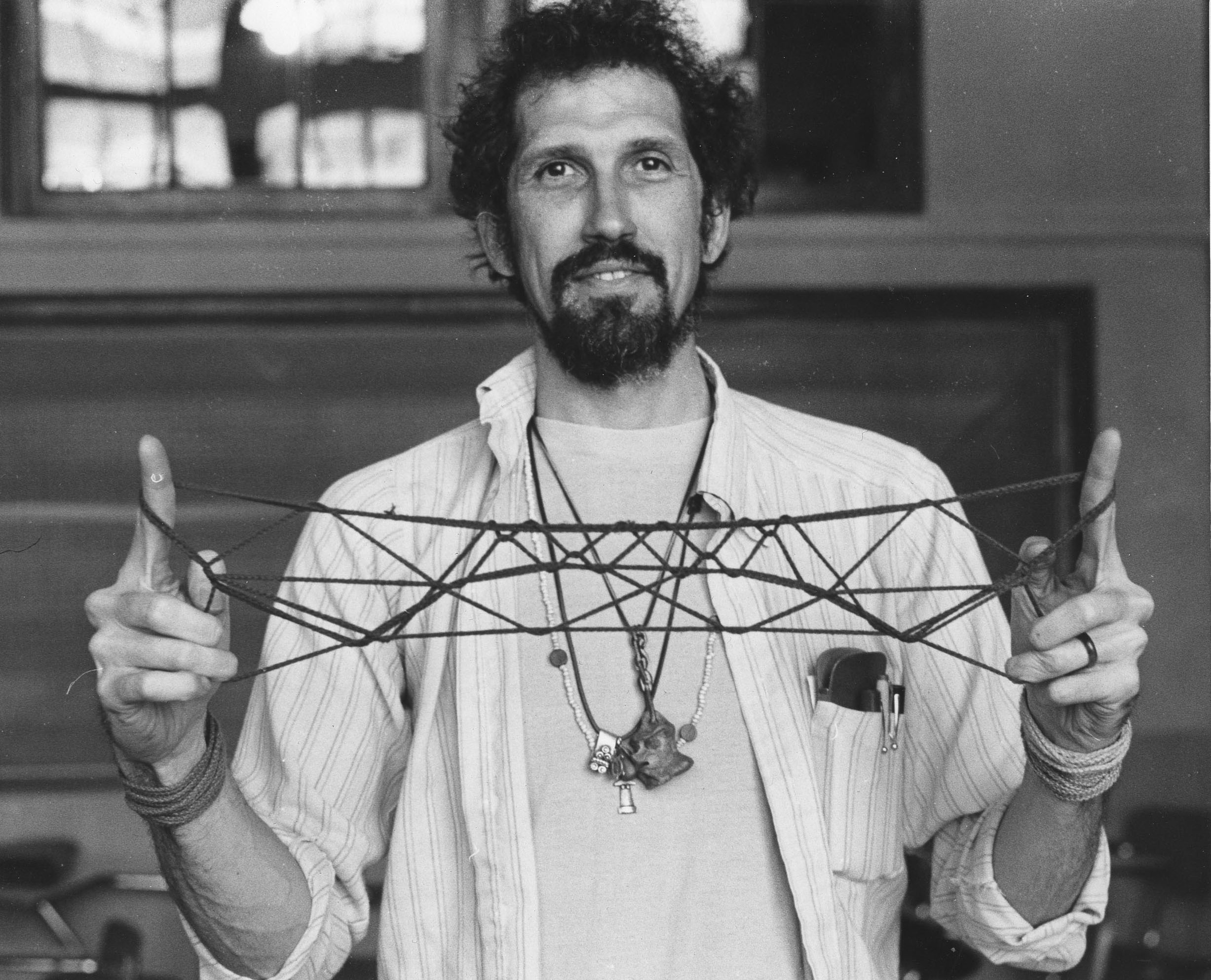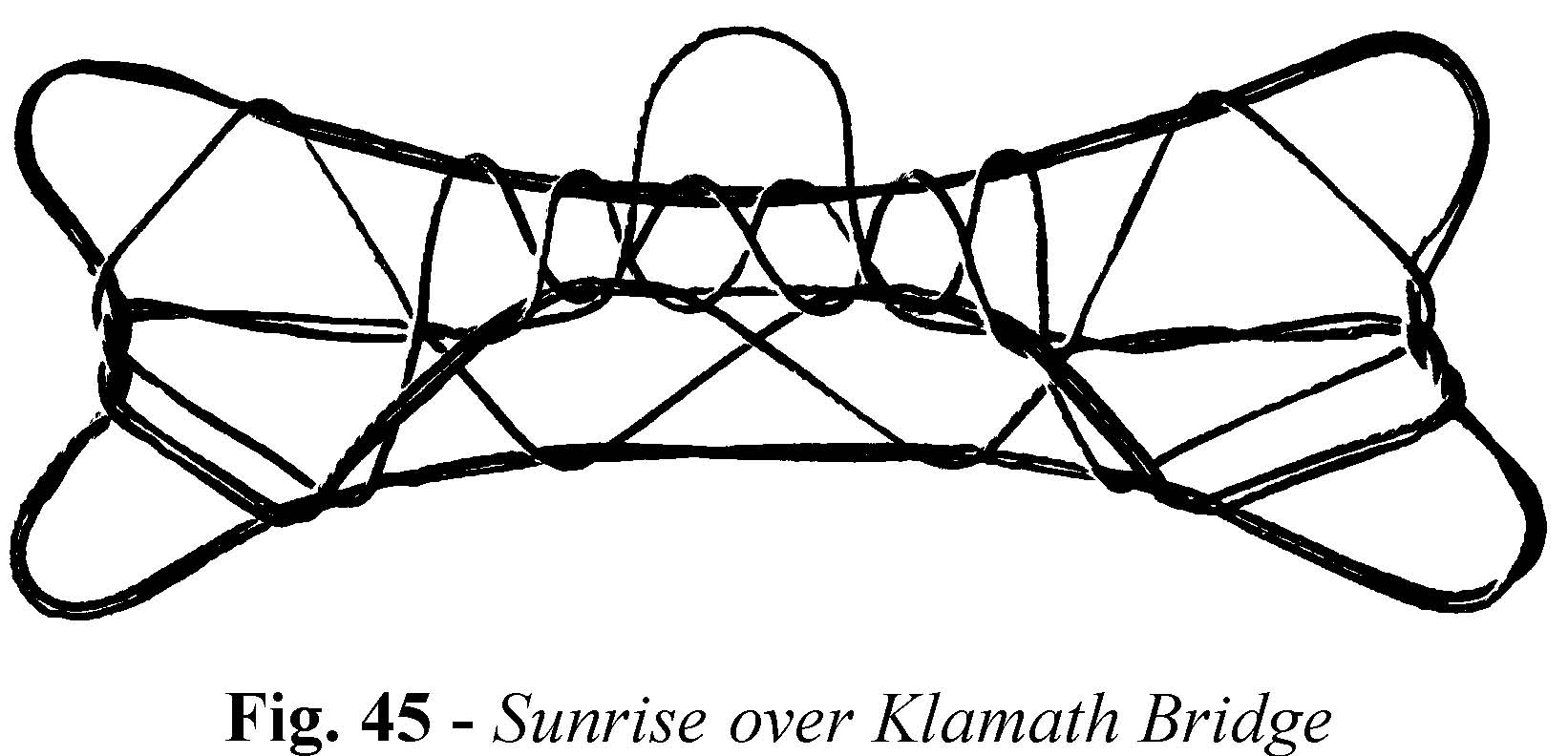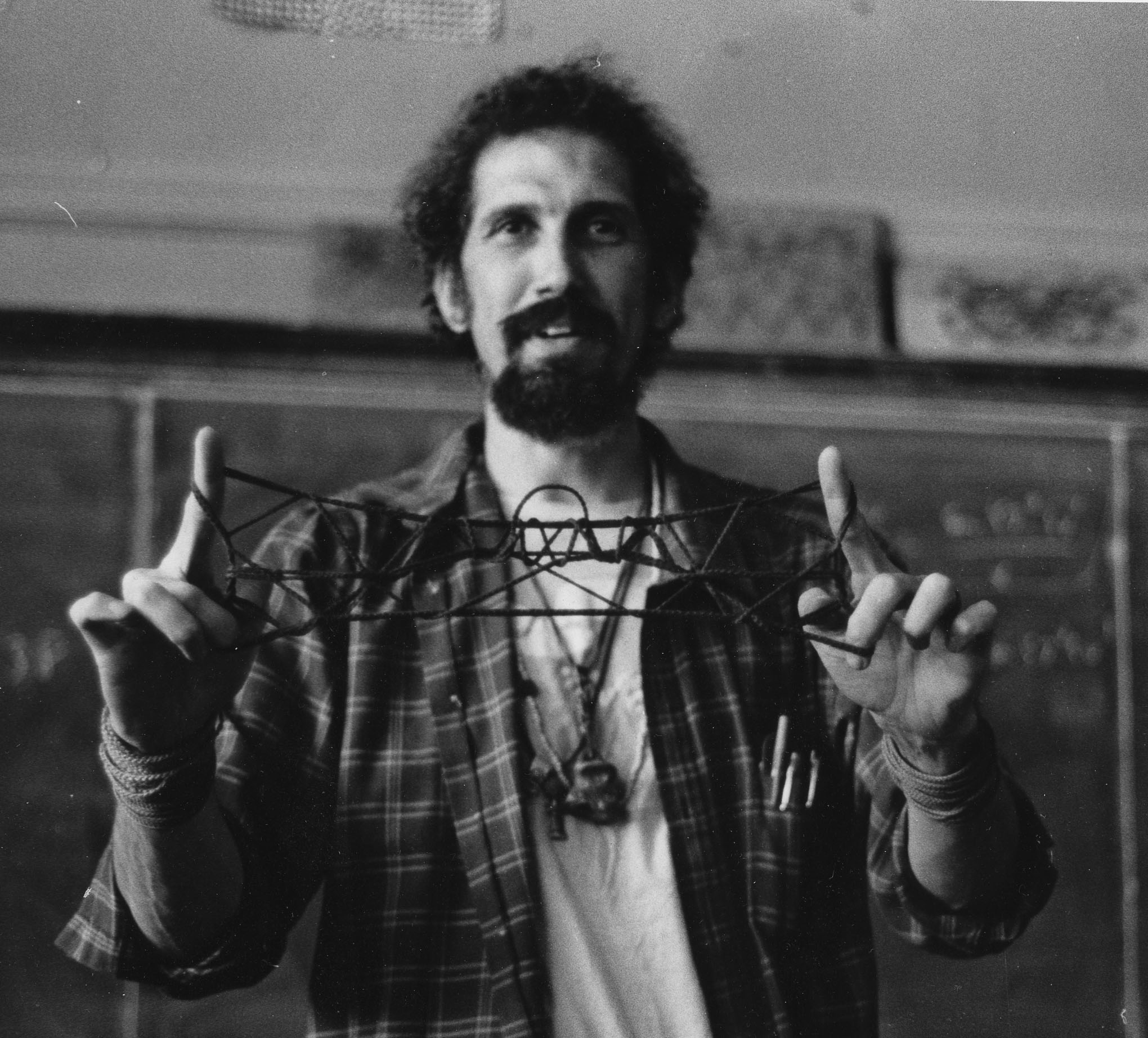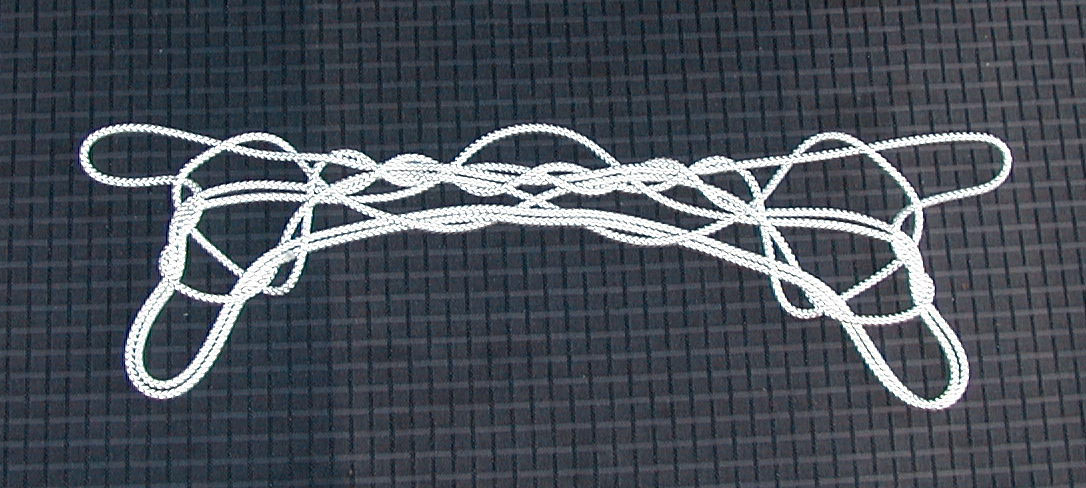advanced north american net figures
The following advanced figures are not difficult once you have mastered the basic figures and the weaving techniques already discussed. Since many of the weaving sequences are quite long and repetitive, the most difficult aspect of making these figures is keeping track of where you are in the sequence. To overcome this difficulty i teach my students how to condense a long sequence into a concise mathematical formula using abbreviations that are meaningful to them. This also teaches them how to think in abstract terms. Examples are provided below.
All of these figures require a loop made from a two-or three-span string (a span being the distance between your fingertips when your arms are fully extended in opposite directions). You will need to use the Power Lift or the Caroline Extension to effectively display the finished design. One figure (‘Murphy’s Mouth’) requires the Two-Diamond Ending followed by the Power Lift. Also essential is a string capable of generating some friction (100% nylon is too slippery). Cotton in all its guises is a favorite.
The term Inuit Out means “make the Inuit Net from the beginning, as if you had Opening A on your hands.” Navaho Out and Klamath Out are similarly defined. The illustrations show how the figure looks when pinned to a board (i.e., the finger loops have been untwisted to facilitate mounting).
Inuit Bridge (fig. 36) This figure features a gently curving arch embedded in a mesh-like array of diamonds, hence the name. The sequence for this figure is:
- Opening A
- First and Second Inuit Weaves
- Continuation Move
- Roll the figure
- First and Second Inuit Weaves
- Continuation Move
- Roll the figure
- First and Second Inuit Weaves
- Continuation Move
- Roll the figure
- Inuit Out
- Power Lift or Caroline Extension
As written, the instructions are hard to follow — you will probably lose your place if you try to read and weave at the same time. But when the sequence is expressed as a formula or equation, the figure is much easier to make. The formula for this figure, when written out in full, is:
Opening A, I-1, I-2, CM, Roll, I-1, I-2, CM, Roll, I-1, I-2, CM, Roll, Inuit Out, Power Lift or Caroline Extension
If we now place the repetitive sequence in brackets, and use a superscript number to indicate how many times to repeat it, the formula becomes:
Opening A, [I-1, I-2, CM, Roll]3, Inuit Out, Power Lift or Caroline Extension
Try making the figure from the formula and you will no doubt succeed much more rapidly! A matrix for creating ‘Bridge’ variations is presented in the Appendix.
Inuit Bowl (fig. 37) This is merely an inverted form of the Inuit Bridge, made by inserting an extra roll between the Inuit Out and Power Lift moves.
Inuit Diamonds (fig. 38) This is a simple variation of Inuit Bridge, the only difference being the addition of an index loop rotation at the end of the repeating unit (full turn away from you). Since rolling the figure requires a +1/2 rotation of the index loop, the extra +2/2 rotation results in a +3/2 rotation of the index loop between repetitive units. The formula for this figure is:
Opening A, [I-1, I-2, CM, Roll, rotate index loop +2/2]3, Inuit Out, Power Lift or Caroline Extension.
Cherokee Seven Stars (fig. 39) In my Ten Men system i prevented reciprocal weaves (a a') from cancelling by inserting a Universe move between them (a Aa'). In the North American Net system you can frustrate the reciprocal weave relationship by rotating the figure on your hands between the first weave (I-1, for example) and its inverse (I-1'). This procedural idea leads to some very interesting designs, one of which i call ‘Cherokee Seven Stars’ (since i am half Cherokee!).
After one repetition of the sequence a star with an octagonal hole is formed in the center of the design. Each subsequent repetition adds two stars with hexagonal centers. So to form seven stars you need to do the repetitive sequence four times. i stop at seven for symbolic reasons: among the Cherokee, it is customary to consider the welfare of the next seven generations in all the decisions we make. The formula for this figure is:
Opening A, [I-1, IM, I-1', IM, rotate index loop +2/2], Inuit Out, Power Lift or Caroline Extension
Again, be aware that the Iteration Move (IM) ends with a +1/2 rotation of the index loop. When combined with the +2/2 rotation that follows, the net effect is a +3/2 rotation of the index loop between the repetitive units. A matrix for creating ‘Cherokee Star’ variations is presented in the Appendix.
ALTERED LOOM VARIATIONS
The following series of figures is a sample of what you can do with looms that have been modified using the Katilluik maneuver as a means of doubling selected loops. Since the doubled loop has a transverse string and a non-transverse string on the near (or far) side, it is interesting to see what happens when only one of the two strings is selected for weaving.
Navaho Release One of my students discovered this figure by accident when a loop slipped off his index finger. I call it a “release” because the center dissolves during the final extension.
- Opening A
- Katilliuk the thumb loops, then Katilluik the little finger loops to form the Double Katilluik Three-Loop Loom.
- First Navaho Weave (N-1), picking up only the non-transverse near little finger string in part 1 of the weave (in part 2 pick up both far thumb strings).
- Do an altered Second Navaho Weave: Pass each thumb away from you over the near index string and the far index string and under all other strings, then pick up the (double) far little finger string and return.
- Continuation Move
- First Navaho Weave (N-1), picking up only the non-transverse near little finger string in part 1 of the weave (in part 2 pick up both far thumb strings).
- Do an altered Second Navaho Weave: Pass each thumb away from you over the near index string and the far index string and under all other strings, then pick up the (double) far little finger string and return.
- Drop the index loop, then insert the index, from below, into the double middle finger loop and separate the two fingers as far as possible to extend the figure in three dimensions (you don’t need a Power Lift or Caroline Extension to display this figure). The formula for this figure is:
Opening A, Katilluik thumb and little, [N-1 (non-tv only), N-2 (over near and far index), CM]1, N-1 (non-tv only), N-2 (over near and far index), drop index, widen middle finger loop with index.
Navaho Cage Same as Navaho Release, but start with a ‘Left DNA Opening’ (Murphy 1998:196) rather than Opening A. In the final extension, when you drop the index loop, the center will “catch” rather than dissolve, and produce a nice three-dimensional figure with four frame lines. The formula for this figure is:
Left DNA Opening, Katilluik thumb and little, [N-1 (non-tv only), N-2 (over near and far index), CM]1, N-1 (non-tv only), N-2 (over near and far index), drop index, widen middle finger loop with index.
Murphy’s Mouth (fig. 42). This figure is my daughter’s favorite, largely because it is animated. It is a hybrid figure that combines elements of the ‘Navaho Release’ figure and ‘Cherokee Seven Stars.’ Two anti-inverse Navaho weaves are used as finishing moves to introduce half-hitches into the design. The half-hitches act as pulleys that allow the mouth to open and close.
- Opening A
- Katilliuk the thumb loops, then Katilluik the little finger loops to form the Double Katilluik Three-Loop Loom.
- First Inuit Weave (I-1), picking up only the non-transverse near little finger string in part 1 of the weave (in part 2 pick up both far thumb strings).
- Iteration Move
- First Inuit Weave Inverse (I-1'), picking up only the non-transverse near little finger string in part 1 of the weave (in part 2 pick up both far thumb strings).
- Iteration Move
- First Inuit Weave (I-1), picking up only the non-transverse near little finger string in part 1 of the weave (in part 2 pick up both far thumb strings).
- Iteration Move
- First Inuit Weave Inverse (I-1'), picking up only the non-transverse near little finger string in part 1 of the weave (in part 2 pick up both far thumb strings).
- Iteration Move
- First Navaho Weave Anti-Inverse (N-1''), picking up only the non-transverse near little finger string in part 1 of the weave (in part 2 pick up both far thumb strings).
- Do an altered Second Navaho Weave: Pass each thumb away from you over the near index string and the far index string and under all other strings, then pick up the (double) far little finger string and return.
- Continuation Move
- First Navaho Weave Anti-Inverse, picking up only the non-transverse near little finger string in part 1 of the weave (in part 2 pick up both far thumb strings).
- Do an altered Second Navaho Weave: Pass each thumb away from you over the near index string and the far index string and under all other strings, then pick up the (double) far little finger string and return.
- Drop the index loop, then insert the index, from below, into the double middle finger loop and separate the two fingers as far as possible to extend the figure in three dimensions.
- Drop thumb loop.
- Withdraw the middle finger from the loop surrounding the index and middle finger. You now have a loop on each index and each little finger.
- Now do movements three, four, five, and six of Jayne’s ‘Osage Two Diamonds’ (1962:28-30). These steps are also illustrated in my first article (Murphy 1997:58, fig. 1, illustrations D through L). The extension is on thumbs and indices, with palms facing away from you (fig. 42).
- After completing the Two Diamonds Ending, transfer the thumb loop to the little finger by passing each little finger under the index loop, picking up the near thumb string, and releasing the thumb loop.
- Transfer the index loop to the thumb, inserting the thumb from below. The figure now lays flat between your hands.
- Now proceed with the Power Lift: With each thumb pick up the near little finger string.
- Pass the index and middle fingers toward you over both strings of the upper thumb loop and pinch between them the lower near thumb string, then wrap the string around the tip of the index by rotating the pair away from you and up, lifting the string over the upper thumb loop as you straighten the index and middle fingers.
- This completes ‘Murphy’s Mouth.’ In the center you should have a “hole” with a row of diamonds above and below. The diamonds represent teeth. To expand and contract the central design (i.e., to see the mouth “chew”), repeatedly separate the indices and little fingers as far as possible while pushing the thumbs toward the center of the figure (two ringlets tightly encircle each thumb). The formula for this figure is:
Opening A, Katilluik thumb and little, [I-1 (non-tv only), IM, I-1' (nontv only), IM]2, N-1'' (non-tv only), N-2 (over near and far index), CM, N-1'' (non-tv only), N-2 (over near and far index), drop index, widen middle finger loop with index to create 3D figure, drop thumb, withdraw middle finger, Two Diamonds Ending, Power Lift.
HYBRID OR CROSS-SYSTEM VARIATIONS
The following are hybrid figures that begin in the Ten Men system and end in the North American Net system.
Double-Arch Bridge (fig. 43) This figure combines the basic Ten Men figure with the Inuit Bridge.
- Ten Men Loom
- In the Ten Men System, do the following two weaves: a a
- Switch to the North American Net System using Method 1 (see page 182).
- Roll the figure
- Now make the Inuit Bridge (Bridge, not Net!) from the beginning, as if you had Opening A on your hands. The formula for this figure is:
Opening A, Ten Men Loom, a a, switch to Net System, Roll, Inuit Bridge Out.
Klamath Bridge (fig. 44) This figure starts with an altered Ten Men Loom and ends with a Klamath Net. Three simple Ten Men weaves are incorporated.
- Ten Men Loom
- Katilluik the upper and the lower index loops (Murphy 1998:178) to give a Double Katilluik Ten Men Loom.
- In the Ten Men System, do the following three weaves: a a c
- Switch to the North American Net System using Method 1 (see page 182).
- Now make the Klamath Net from the beginning, as if you had Opening A on your hands. (Interesting fact: as you complete the first Klamath weave, you should notice a “release” or “reduction of complexity” in the figure that was created by doing the c weave). The formula for this figure is:
Opening A, Double Katilluik Ten Men Loom, a a c, switch to Net System, Klamath Out.
Sunrise over Klamath Bridge (fig. 45) Same as Klamath Bridge, but with additional modifications made to the loom so that a small upright loop hovers above the finished pattern. A string capable of generating some friction is essential: i usually call this sunset over klamath bridge.
- Ten Men Loom
- Katilluik the upper and the lower index loops (Murphy 1998:178) to give a Double Katilluik Ten Men Loom.
- Continue to alter your Ten Men Loom as follows: Do an opening 6 weave (Murphy 1998:179), downflipping only the non-transverse far lower index string. Recall that the opening 6 move is like doing a b' weave on the lower index loop rather than the little finger loop.
- As a final loom alteration, do an opening 3 weave (Murphy 1998:179), picking up the transverse far lower index string only (recall that an opening 3 move is like doing a b weave on the lower index loop rather than the little finger loop). Also, when retrieving the transverse string, make sure each thumb passes over the non-transverse far lower index string (i.e., the single string that wraps around the double upper index loop). This ensures a dramatic “sunrise.”
- Now you are ready to weave. Do the a a c weaving sequence, as in Klamath Bridge.
- Switch to the North American Net system using Method 1 (see page 182).
- Now make the Klamath Net from the beginning, as if you had Opening A on your hands. As you extend the figure waggle the hands: a small upright loop representing the sun should appear just above the upper frame line of the figure. The formula for this figure is:
Opening A, Double Katilluik Ten Men Loom, opening 6 (non-tv only), opening 3 (tv only, over non-tv), a a c, switch to Net System, Klamath Out, waggle.
things to consider
note that you should be becoming more adept at considering new ways of using the methods you are now practicing. later lessons will add many more to your repertoire.
